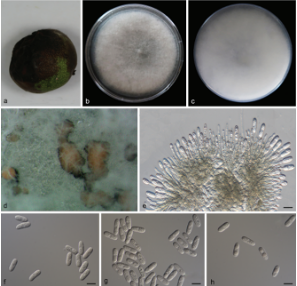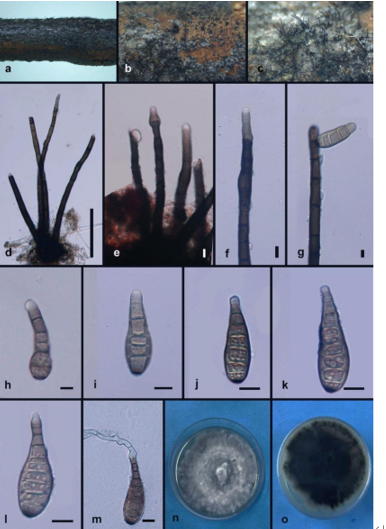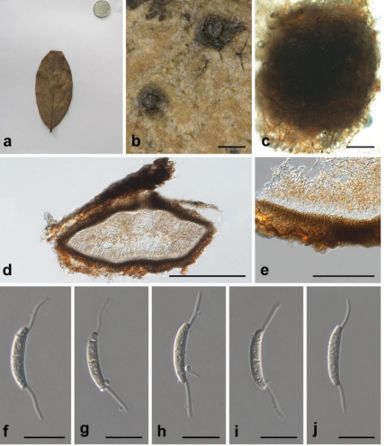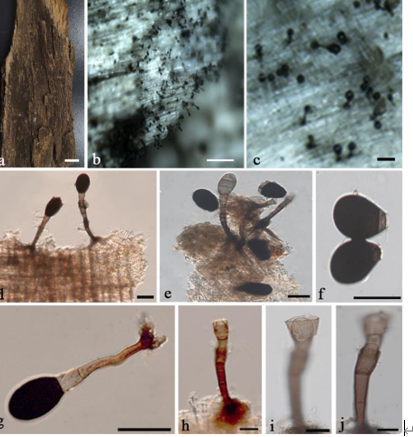Nemania diffusa (Sowerby) S.F. Gray, Nat. Arr. Brit. Pl.: 517 (1821)2021
MycoBank No: 477312
Holotype: Hypoxylon lilacinofuscum Bres., Fl. Trident. Nov. 2: 43 (1892) Hypoxylon cohaerens var. brasiliense Starbäck, Bih. K. svenska VetenskAkad. Handl., Afd. 3 27(no. 9): 8 (1901) Hypoxylon vestitum Petch, Ann. R. bot. Gdns Peradeniya 8: 156 (1924)
Morphological descri.ption
Sexual morph:Stromata effused-pulvinate, clear outline, ellipsoid or irregularly lobed, occasionally confluent into a larger compound stromata, 2–20 mm long × 2–9 mm wide × 0.5–1 mm thick, with conspicuous perithecial mounds, carbonaceous between the perithecia, surface dark brown or brown; the inter-perithecial tissue blackish, carbonaceous; does not release a coloured pigment in 10% KOH. Perithecia 0.3–0.55 diam. × 0.4–0.7 mm high, subglobose to obovoid. Ostioles finely conic-papillate, black, shiny. Asci 130–250 × 6–10 μm (av. = 170 × 8 μm, n = 30), 8-spored, unitunicate, cylindrical, long-stipitate, the spore-bearing parts 70–90 µm, apically rounded with a J+ apical apparatus, 1.5–2.5 × 2–3.5 µm (av. = 2 × 2.6 µm, n = 30), tubular with a faint upper rim, bluing in Melzer’s Reagent. Ascospores 9.5–13 × 4.5–7 μm (av. = 11 × 5.5 μm, n = 30), unicellular, ellipsoid-inequilateral, with narrowly-rounded ends, smooth, brown to dark brown, with a conspicuous, straight germ slit spore-length to slightly less than sporelength on the ventral side; lacking a sheath and appendage; perispore indehiscent in 10% KOH.
Asexual morph: Undetermined.
Cultures: . Colonies grow on PDA at 25 °C for a week reaching a diameter of 5 cm. Colonies are cotton white in colour, flocculent or velvety, dense, circular, radial. On the reverse, white edge, light yellow in the middle. Not sporulating on OA nor on PDA
Habitat: on dead wood
Distribution: China, Guizhou Province, Tongren City, Fanjingshan Nature Reserve (27°53'46.59"N, 108°431'16.29"E, altitude: 1058 m),
GenBank Accession: its MW851877; rpb2 MW836067; tubulin MW836031; catin MW836053.its MW851878;rpb2 MW836068; tubulin MW836032 ; catin MW836052.
Notes: s. The new collection morphologically resembles N. diffusa (Gray 1821), having effused-pulvinate carbonaceous stromata with inconspicuous perithecial mounds, brown to dark brown ellipsoid-inequilateral ascospores (9.5–13.5 × 5–6 µm), with narrowly-rounded ends and a long germ slit on the ventral side (Granmo et al. 1999; Ju and Rogers 2002). Fournier et al. (2018) predicted that N. diffusa might be a species complex as it is difficult to identify, based solely on morphology, thus, it should be evaluated after extensive sampling and using DNA-based taxonomy. In phylogenetic analyses of combined ITS, rpb2, β-tubulin and α-actin genes (Fig. 1), new collections clearly showed its close kinship with N. diffusa. Only a 2% difference of ITS sequences existed between our strains and N. diffusa (HAST 91020401, authoritative strain). Therefore, we regard the new collection as N. diffusa. Nemania carbonacea Pouzar. can be confused with N. diffusa by having the same dark ascospores and nearly sporelength germ slits. However, N. carbonacea has white, soft stromatal tissue between the perithecia (Ju and Rogers 2002)
Reference: [1] Song, Y. J. , & Li, S. Q. . (2008). A taxonomic study of chinese nematogmus species (araneae, linyphiidae). Organisms, diversity, & evolution(4), 8.
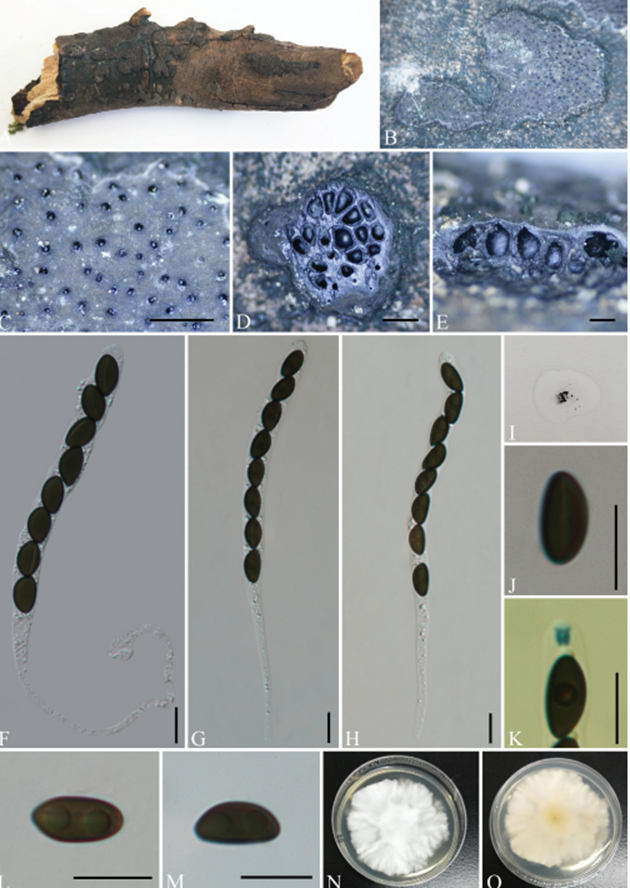
Nemania diffusa (GMB0072) A specimen B, C stromata on the surface of host D transverse sections of stromata E longitudinal sections of stromata F–H asci with ascospores I pigments in 10% KOH J ascospore with indehiscent perispore in 10% KOH K ascus apical apparatus (stained in Melzer’s Reagent) L,M ascospores N, O colonies on PDA (N-upper, O-lower). Scale bars: 0.5 mm (C–E); 10 μm (F–H, J–M)


